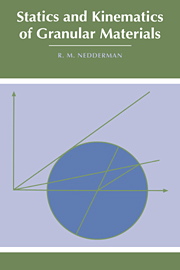Book contents
- Frontmatter
- Contents
- Notation
- 1 Introduction
- 2 The analysis of stress and strain rate
- 3 The ideal Coulomb material
- 4 Coulomb's method of wedges
- 5 The method of differential slices
- 6 Determination of physical properties
- 7 Exact stress analyses
- 8 Velocity distributions
- 9 The Conical yield function
- 10 The prediction of mass flow rate
- Set problems – chapters 2–10
- Appendices
- References and bibliography
- Index
1 - Introduction
Published online by Cambridge University Press: 28 October 2009
- Frontmatter
- Contents
- Notation
- 1 Introduction
- 2 The analysis of stress and strain rate
- 3 The ideal Coulomb material
- 4 Coulomb's method of wedges
- 5 The method of differential slices
- 6 Determination of physical properties
- 7 Exact stress analyses
- 8 Velocity distributions
- 9 The Conical yield function
- 10 The prediction of mass flow rate
- Set problems – chapters 2–10
- Appendices
- References and bibliography
- Index
Summary
A granular material can be defined as any material composed of many individual solid particles, irrespective of the particle size. Thus the term granular material embraces a wide variety of materials from the coarsest colliery rubble to the finest icing sugar. The handling of granular materials is of the greatest importance in the chemical industry, it being estimated that on a weight basis, roughly one-half of the products and at least three-quarters of the raw materials are in the form of granular solids. When one adds to this the vast tonnages of wheat, sugar, iron ore, cement, sand and gravel that have to be stored and transported, the importance of granular materials becomes selfevident. The early dominance of oil in the history of the chemical industry has tended to emphasize the importance of fluid mechanics as one of the main constituents of a chemical engineer's education. It is only relatively recently that the economic advantage of a study of the behaviour of granular materials has been appreciated. One reason for this is that solids handling equipment has long been designed empirically and it is only over the last thirty years that the subject has been placed on a firm numerical basis. By contrast, the quantitative nature of fluid mechanics has been well-known since the work of Darcy in the 1840's.
Granular materials, or bulk solids as they are sometimes called, are usually stored in hoppers or bunkers.
- Type
- Chapter
- Information
- Statics and Kinematics of Granular Materials , pp. 1 - 6Publisher: Cambridge University PressPrint publication year: 1992
- 1
- Cited by



